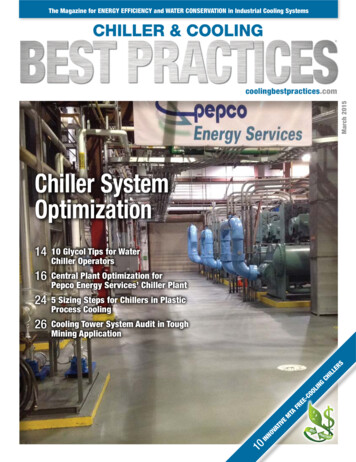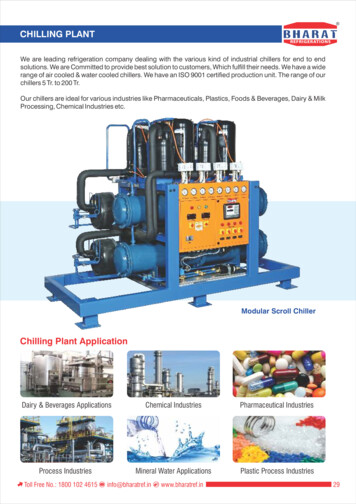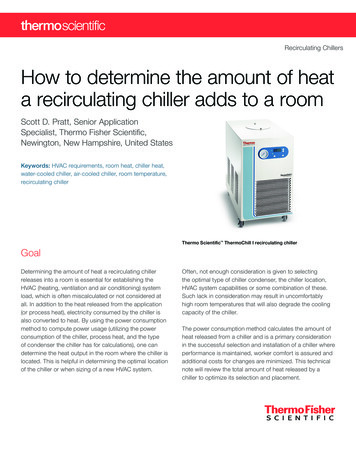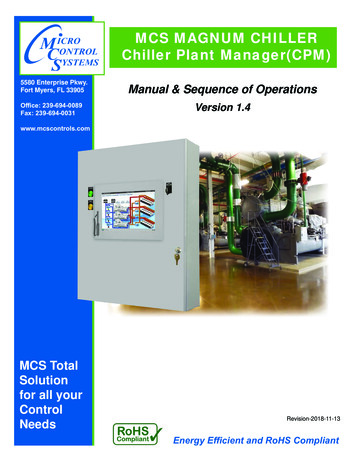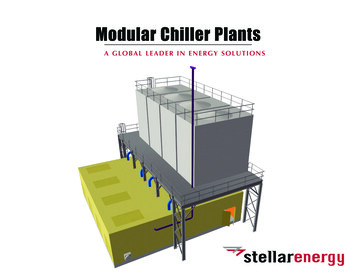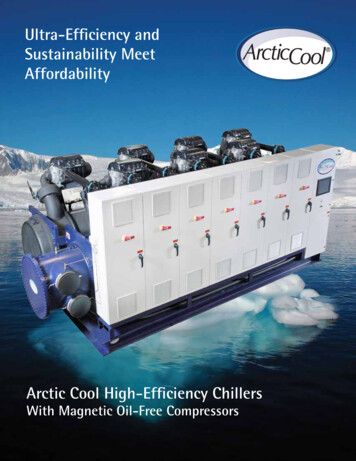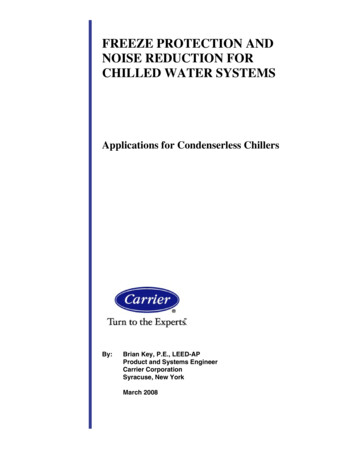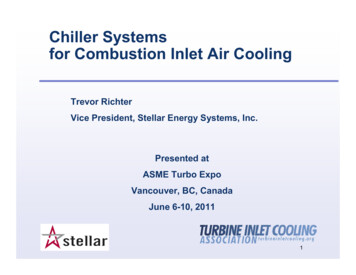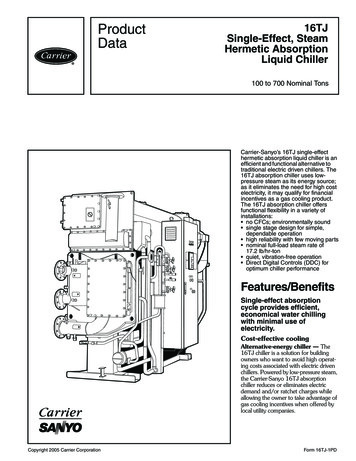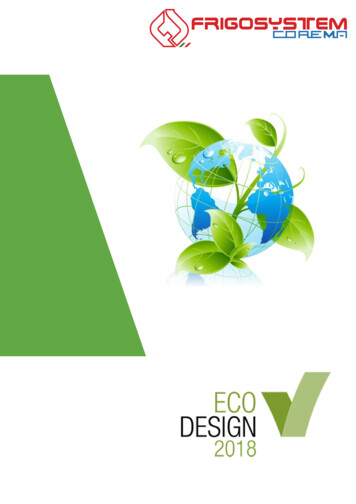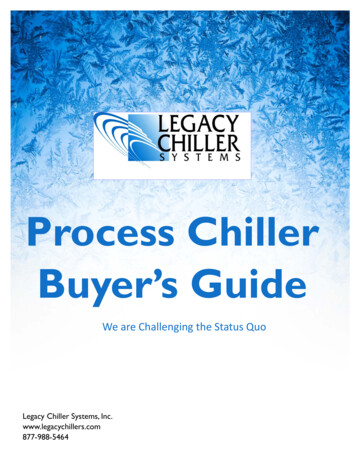
Transcription
Legacy ChillersProcess ChillerBuyer’s GuideWe are Challenging the Status Quo
Process Chiller Buyer’s Guide - SectionsPage(s)Introduction to Process Chillers - Uses for this Buyer’s Guide3Potential Markets for Process Chillers4-5Process Chiller Duty Cycle6Air-Cooled and Water-Cooled Chillers7Common Process Cooling Configurations8-9The Dark Side of Chiller Manufacturing - What Chiller ManufacturersDon't Tell You10 - 11Features Matter12 - 13Controls Matter14 - 15Process Chiller Controls - Scorecard16 - 17
After competing in the HVACR equipment market for over threedecades, we have learned a lot and we want to share what we havelearned with you.On a regular basis, Legacy invests in extensive research to betterunderstand market demands and how the US and foreign process chillermanufacturing community is addressing these demands.In our most recent research cycle we noticed some concerning trendsthat, if not addressed, have the potential to impact users of processchillers in a negative way. We believe these trends may, in part, be aresult of a sluggish economic recovery. More than ever before we areseeing the line between price and overall value getting very distorted.The result of this distortion is making it even more difficult to effectivelyshop for the best possible process chillers, and the best overall value.Regardless of your experience we have structured this Buyer’s Guide toprovide easy to understand facts that should be considered whenmaking your next investment in a process chiller.I hope you find this Process Chiller Buyer’s Guide to be helpful, and onbehalf of my engineering, sales and manufacturing teams we lookforward to working with you soon.
Laser Applications: In the semiconductor and printed circuit boardLegacy designed cooling for AdvancedLaser Systemindustries, lasers take on a crucial role. Lasers are also increasingly used for theproduction of flat panel displays, including high-resolution screens forsmartphones and tablet computers, as well as large LCD and OLED displays fortelevision sets. Another growing application field for laser micro processing isthe production of solar cells, where laser structuring helps to increase cellefficiency. As the laser market evolves, the ability to remove heat becomes acritical challenge. Process chillers have become the main cooling apparatus thelatest generation laser systems.Food Production: Process chillers are in wide use throughout the world'sfood supply. In food processing, fluid cooling is needed for: milk (and otherconsumable drink pasteurization), washing of fruits and vegetables, bakedgoods, commercial/industrial ice machine pre-cooling, and jacket cooling.Legacy designed cooling for milk and dairyproduction.Military: Over the last two decades, leading military hardwareLegacy OEM designed cooling for thePatriot II Missile defense systemproducers, many within the United States, have been called to designeven more durable systems for rapid deployments anywhere in theworld. Unlike military hardware of two decades ago, these new systemsare highly dependent on computers and other semiconductor basedsystems that are highly temperature sensitive. As these high-tech systemsbecome an integrated part of the world defense, network cooling iscritical. In these environments a new generation of highly durable,lightweight and compact processchillers are needed.Semiconductor Test: As the processors that run inside popular electronicequipment such as smartphones, personal computers, servers, and industrialrouters double their performance every 12-18 months, new fluid cooled testsystems have entered the market. These test systems, and their extraordinaryrequirements for efficiency and reliability, have set the bar high for processchiller manufacturers.Legacy OEM designed cooling for HewlettPackard / Agilent 93000 SOC test system.
Wine / Beer Production: Wine and beer production have become anincreasingly competitive business over the last decade. Process chillers areused to control fermentation and condition products, such as white wine,before it can be sent off to market. As production operations grow, the needfor reliable process chillers also grows. Downtime or inefficient operation ofprocess chillers can make the difference in whether a company turns a profit.Legacy designed cooling for wine and beerproductionMedical Imaging: As healthcare systems of the world evolve, diagnosticimaging has become a key factor in cost controls. As compared to performingmore invasive procedures, such as exploratory surgery MRI, PET and otherimaging systems can now be used to reduce risk and cost to efficientlydiagnose and treat patients. Process chillers are commonly used to cool thesehighly advanced imaging systems. Process chillers used for imaging applicationis considered to be “Mission Critical” — meaning downtime must always beLegacy OEM cooling application for Toshiba,kept to a minimum.Siemens, GE and Philips imaging systemsTelecommunication Shelters: With the rapid expansion of cellularand data services worldwide, site owners are becoming increasinglyconcerned about external environmental impact issues such as sound andoperating efficiency, as well as internal factors that can affect the lifeexpectancy of the components inside these shelters.Legacy designed cooling for cellular and otherremote, outdoor telecommunication sheltersData and Telecommunication Centers: With the ever increasingdensity of data and telecommunication centers, process chillers haveproven to be the best overall solution for cooling. With recent trendsincreasing internal climate temperature to as high as 80F, chillersintegrated with economizers can dramatically reduce cooling costs andreduce carbon footprint.Legacy designed cooling and economizer systemsfor data and telecommunication centers
In the world of chillers, there are two major classifications (or duty cycles) that describe how a chiller is used.These duty cycles tend to be either Process or Air Conditioning. When buying a chiller it is important to firstunderstand some of the key differences of these two classifications. We have illustrated some of the keydifferences in the table below. As with any machinery, it is very important to buy equipment that effectivelyaddresses the operational requirements.OperationalRequirementsAir Conditioning Duty ChillersProcess ChillersAnnual usage hours1080 Hours2900 HoursOperational conditionsOutdoor, rain, snow, wind, generallyground installed, coastalIndoor (corrosive), outdoor, rain,snow, wind, ground installed, roofinstalled, coastalFluid pumping requirementsNarrow range generally between 20and 50 PSI pump differential pressureWide range generally between 10 and150 PSI pump differential pressureRedundancy of both pumpingand coolingModerate needCritical needImpact / cost of chillerdowntimeLow to moderateHigh to extremely highExpected useful life ofequipment with basicmaintenance10 to 15 years20 to 25 yearsNeed for fluid freeze protectionModerate needModerate to high
One of the most frequently asked questions by customers is, “What is the difference between an air-cooled vs awater-cooled chiller?” Below, you find an example of each. You will note that the refrigeration systems in theseexamples are virtually identical. On the top left of each drawing we have inserted an arrow indicating the one andonly major difference in these two systems. In the case of an air-cooled chiller (example #1), heat is rejected to theoutside air. This process is very similar to how an automobile rejects heat to the air by way of a radiator. In thecase of a water-cooled chiller (example #2), heat is rejected to another water source such as a cooling tower.Example #1 : Air-Cooled Process Chiller SystemExample #2 : Water-Cooled Process Chiller System
Once through: The illustration below represents a once through process cooling configuration. Theseapplications are common for loads not especially susceptible to wide variations in process load inlettemperatures. Although this illustration shows an internal chiller tank, it is common for once through applicationsto not use a tank, provided the process loop has enough overall fluid volume.Heat ExchangerProcessLoadTankSystem PumpOnce Through System ConsiderationsAdvantages Total cost of chiller tends to be lessLower energy costsSlightly lower maintenance costIdeal for process loads that can handle a widerange of temperatures when load fluctuatesDisadvantages Process inlet temperatures can fluctuate withchanges in load.Chiller’s refrigeration system can be impacted byway of flow changes in process. If flow dropsbelow minimum of 2.5 GPM per ton of coolingchiller may shut down.Pressure drop of chiller’s internal heat exchangermust be considered when sizing of system pump.
Recirculation: The illustration below represents a recirculation process cooling configuration. Thisconfiguration is by far the most popular for process fluid cooling by way of its overall flexibility and reliability.ProcessLoadHeat ExchangerTankSystem PumpRecirculation PumpRecirculation System ConsiderationsAdvantages Provided the process chiller is properly sized, recirculation systems can provide very stable inlet temperature to the process loadChiller’s refrigeration systems are not dependenton fluid demand (or changes) in the process fluidloopThe chiller’s heat exchanger are not a factorywhen sizing the System pumpProcess loads that require less than the minimumof 2.5 GPM per ton can be serviced with no impacton the chiller’s cooling operationDisadvantagesSlightly high maintenance costsHigher initial investment
Our recent research has uncovered some concerning trends in the world of chiller manufacturing. On thefollowing pages we will outline some of these trends and their impact on your chiller buying decision. As youreview this information, please keep in mind that our intention is not to beat up on the competition. Our intentionis to highlight key design items that, in our view, can have a moderate to significant impact on the value and1. The ETL Listed Mark: Similar to the UL mark that is found on many consumerelectronic items, the ETL mark is used by many refrigeration equipment manufacturers. TheETL mark is a critical certification that the prospective chiller buyer must look for assuringthat every electrical component used in the subject equipment meets UL or ETL standardsof performance and reliability. Unfortunately, there is a growing number of US and foreignchiller manufacturers that either do not bear the ETL mark, or in some extreme cases,display the mark and make claims such as “ETL / UL Listed” or “ETL / UL Certified” with no real listing. The processto legitimately bear the ETL mark requires extensive qualification and testing. Once a chiller line has beenassigned the ETL mark, the manufacturer is required to maintain and submit to regular recertifications to maintainthe ETL mark. If a process chiller project is to be permitted, many municipalities will require the ETL mark in orderto approve the project. In some cases where electrical equipment is responsible for personal injury or propertydamage, insurance companies have been known to reject claims on the basis of non-ETL or UL listings.2. The MIXED DESIGN System: In recent years, mixed design chillers have entered the marketand they appear to be on the rise. These chillers are generally less expensive; however there are sometradeoffs that some manufacturers are reluctant to openly disclose.The image to the left illustrates a mixed design chiller system. In this case, the chiller manufacturerhas purchased a residential air conditioning duty condensing unit, mounted it to a manufacturedframe with doors then installed a chiller barrel and a pump. Although mixed design chiller systems dohave their place on the market, there are some things that an informed chiller buyer should know:a. Although the condensing unit (top section) may openly display the ETL/UL mark, in most cases the entirechiller unit has not been ETL/UL listed.b. Manufacturers of mixed design chillers may openly market these systems as process duty chillers; however aresidential condensing unit is not engineered for a process duty workload. As a result, even with regularmaintenance, air conditioning duty equipment has a life expectancy of about half compared to a processduty designed chiller.c. Since mixed design chillers tend to be positioned in the market as a low cost alternative, manufacturers tendto use lower cost components and change vendors often. This can lead to more frequent breakdowns as wellas longer lead times on replacement parts. Here are a few items to look out for: Pump Impellers: Tend to be plastic or nylon. Over a relatively short period of time these tend to losepumping capacity or break down. Pump seals: Tend to be constructed of materials that can overheat or be susceptible to damage from sometypes of glycol or system cleaning chemicals. Evaporators: The chiller evaporator is one of the most important components in the entire chiller system.
Its job is to remove heat energy from the process fluid. On mixed design systems, evaporators tend to beconstructed of substandard materials such as all copper, brass or even steel in some cases. These materialstend to be susceptible to premature failures. In some cases a damaged evaporator can also damage thechiller’s compressor requiring replacement of the entire chiller. Indoor rated: Although the condensing unit (top section) may be outdoor rated, the lower section iscommonly not. Since many of these lower sections are not cleared by way of the ETL/UL listing process,owners may not be aware that these mixed design machines are indoor rated only. Installing mixed designchillers outdoors can result in failure of the system. In some extreme cases, these systems can be consideredunsafe for outdoor use. Replacement parts: Loyalty between the chiller manufacturer and component vendors is critical.Unfortunately, it is common for manufacturers of mixed design chillers to change component vendorsregularly to maintain the best possible price point. Customers who choose to purchase mixed design chillerscan run into difficulties getting the parts they need quickly, leading to extending downtime. It is also commonto have manufacturer provided replacement parts show up that do not match the original part. This can alsolead to extended downtime and increased repair costs.3. Made in the USA?: Over the last two decades, some USA based chiller manufacturershave moved some or all of their production offshore to gain a competitive edge here at home.It has been argued that finding ways to make more profit, by way of getting workers to buildthings at a lower cost, is good for business. When it comes to process chillers, and the endusers that depend on fluid cooling for their business operations, there is a growing argumentthat lower initial investments costs may not equal the best overall value. Here are a few things to consider: Design flexibility: Producing products offshore naturally results in communication challenges. A customer’sdesign request needs to travel long distances, time zones and in some case language barriers to getaddressed. To offset these challenges, many companies who produce offshore dramatically limit theiroffering to a very narrow set of designs. These limitations may not be known until the end of a purchase andcan add to the overall cost of the equipment. Security: In the case of Mission Critical process systems that are highly dependent on the application andoverall reliability of a process chiller, customers may need to share sensitive information with a chillermanufacturer. Chiller buyers who share such information, regardless of a Non-Disclosure Agreement (NDA),may be at risk if the design information happens to be shared with other (offshore) subsidiaries who are notsubject to US laws. In some cases manufacturers may not fully disclose who the information is being sharedwith, creating an atmosphere of risk. Lead times: The more geographical distance between the manufacturer and the chiller's final destinationnaturally requires a more extensive supply chain. The more complex the chain, the more potential forinterruptions and increased lead times. These potential interruptions can happen as a result of many factors,including but not limited to weather, geopolitical problems, and customs. When these interruptions happen,lead times tend to increase which can add to project delays, or in the case of replacement parts, extendeddowntime.
Life Cycle Costs Matter: With the number of choices out there it can be a challenge to uncover the best overallvalue of a process chiller. One of the most effective ways to analyze the value of an investment is to first look atthe initial investment versus the life cycle costs. In the graphic below, we have provided a breakdown of the eightmajor cost categories for a process chiller. Interestingly, the initial cost to purchase a process chiller is only about10% of the overall cost throughout the equipment's life cycle .Plant Performance Services Group, ITTFeatures Matter: Based on extensive market research, we have identified specific process chiller features knownto increase the overall reliability and extend its life cycle. In the table below, we have identified each of these keyfeatures and their application within a process chiller.Key FeatureFeature ApplicationStainless SteelEvaporatorA chiller’s evaporator is a critical component that removes heat from the process fluid. Constantlyexposed to the process fluid, stainless steel (especially grade 316) is the most durable material to beused for fluid process cooling.Stainless Steel PumpImpellersLike the chiller’s evaporator, the pumps impeller is constantly exposed to the process fluid. Stainlesssteel (especially grade 316) can dramatically extend the life cycle of a chiller.Liquid Line SolenoidIn the refrigeration system, having an automatic liquid line solenoid valve in the system preventsmigration of refrigerant in the off cycle. This prevention reduces wear on the chiller’s compressor.Powder Coated Painted A cabinet’s paint coating is the first line of defense in protecting the chiller’s internal componentsCabinetfrom the elements. The powder coating process prevents peeling or flaking paint protection.Suction AccumulatorIn the refrigeration system, a suction accumulator mounted between the chiller’s evaporator outletand the compressor provides an additional layer of protection to the chiller’s compressor.Machine Bent CopperTubingCopper joints in the chiller’s fluid and refrigeration systems have the highest possibility of leaks.Machine bending can reduce the number of fittings by 60%, also reducing leak potential.Hot Gas BypassUnder low load conditions, the hot gas bypass feature provides capacity control. Additionally, thisfeature provides an additional level of freeze protection helping to prevent catastrophic failures.
chiller options.Graph indicates potentialREPAIR COSTS for a chillerdeployed in a processapplication equipped withstandard features . In thisgraph, the total potential repairexpenditures in its life is: 14,568.00Graph indicates potentialDowntime Days for a chillerdeployed in a process applicationequipped with standardfeatures . In this graph, the totalpotential repair expenditures inits life is:24.75 DAYSGraph indicates potential REPAIRCOSTS for a chiller deployed in aprocess application equipped withupgraded features . In this graph,the total potential repairexpenditures in its life is:* 8,535.00* 59% reduction in repair costsGraph indicates potential DowntimeDays for a chiller deployed in aprocess application equipped withstandard features . In this graph, thetotal potential repair expenditures onits life is:* 11 DAYS* 44% reduction in downtime days
Controls Matter: As micro processers have evolved over the last few decades, process chiller manufacturersnow have unique opportunities to provide enhanced control features in a cost effective way. In this table we havelisted features considered to be CRITICAL in today’s process chiller market. We have placed these items in order ofimportance based on extensive customer interviews and 2013 market research. As with products that useprogrammable controls, developments can occur at a very fast pace. For this reason, we encourage our customersto look for future updates to the Process Chiller Buyer’s Guide for the latest trends.CRITICAL - Control FeaturesControl Key FeatureFeature ApplicationThe ability to update the control interface (screen) and / or the programmable logiccontroller without needing to remove these devices from the chiller. A commonIn-Place Screen and PLCmethod is to download updates, ideally at no cost to the customer, from theSoftware Updatesmanufacturer's website and transfer the files to the chiller’s equipment via a USBjump drive.This critical feature assures equal wear and tear on the chiller’s compressor(s). OnceMulti COMPRESSOR the lead compressor run hours have extended past the lag compressor hours byAutomatic Lag/Lead approximately 500 hours, service duty of the compressors will switch.This critical feature assures equal wear and tear on the chiller’s system pumps. Oncethe lead pump run hours have extended past the lag pump hours by approximately500 hours, service duty of the pumps will switch.In some cases, process chillers are mounted in remote locations. In these cases, it mayRemote Start / Stop be advantageous to have the capability to turn the chiller on / off remotely. Having aninput on the chiller’s control system to perform start / stop is a critical feature.Using a standard Internet browser, such as Internet Explorer or Firefox, user has theIntranet Remote Controlability to access and control the chiller over a local area network. Note: In most casesAccess via Browserthis will require custom IP addressing.Using a standard Internet browser, such as Internet Explorer or Firefox, user has theInternet Remote Controlability to access and control the chiller over a wide area network. Note: In most casesAccessthis will require custom IP addressing and firewall port forwarding.Virtual Private Networking (VPN) is used to connect a process chiller remotely over aVPN Secure Remotesecure network connection. A VPN can be used to remotely connect to a chiller via anConnectivityIntranet or Internet connection. VPN typically does not require firewall configuration.Process chiller control systems use pilot duty relays to control the various systemswithin the chiller such as compressors, pumps, fans and economizers. When theseReplaceable Pluginrelays are board mounts it requires replacement of the entire board as compared toControl Relaysfield replaceable plugin relays that result in much less downtime and cost.Should a process chiller’s operating condition become unstable, it is considered idealRemote Alarming via for the chiller’s control system to broadcast a trouble email or text. Note: In order tobroadcast the chiller must be connected to the host building’s network with access toEmail or Textthe Internet. Some firewall configuration or VPN connection may be required.Multi PUMPAutomatic Lag/Lead
Controls Matter (Continued): The table below represents features to be considered by the process chillerIMPORTANT - Control Featuresmarket to be IMPORTANT but not yet a critical need. According to our research many of these items areexpected to become considered as critical control features over time. We have BOLDED control features mostlikely to make the jump from important to critical in the next 24 to 36 months.Control Key FeatureFeature ApplicationHighly Visible UserInterfaceProcess chillers operate in many indoor and outdoor applications. It is important thatthe user interface is visible, especially in bright sunlight situations, in order to easilycontrol the features of the chiller control system.On-Screen User HelpInformationIt’s a common occurrence for the chiller control and other documentation todisappear during or shortly after the chiller installation. An important feature is tohave electronically stored use and troubleshooting documentation available on theprocess chiller’s user interface.An important feature is to have event history stored on the process chiller’s userOn - Screen Event Logging interface. The information can dramatically reduce diagnostics time especially whenintermittent issues occur.Expandable MemoryMulti-Chiller Lag LeadOpen Modbus (SLAVE)Register Availably viaTCP or RTU (Serial)Expandable ControllerI/OAs new process chiller control enhancements become available, demands on internalmemory will inherently increase as well. As demand for memory grows, it is veryimportant to have the capability to expand the control system memory.In Mission Critical process chiller applications it is common to deploy multiple chillersto achieve cooling redundancy. In these circumstances multiple chillers mustcommunicate and have the ability to perform lag-lead functions.Since most process chillers are deployed within modern buildings that are equippedwith building automation systems it is important to be able to read in, and in somecases control chiller functions from these building systems.It is becoming more common for process chillers, post installation to requireenhancements to meet site specific requirements. In many cases theseenhancements will require more I/O. It is considered an important feature to havethe ability to expand a process chiller’s control system at any time.
Use of this scorecard: As process chillers buyers search to find the best overall best value, we have providedthis unique scoring system to help Buyers ask the right questions and compare key features across the variousprocess chiller brands being researched.FeatureLegacyIn-place Screen and PLC Software UpdatesStandardMulti COMPRESSOR Automatic Lag/LeadStandardMulti PUMP Automatic Lag/LeadStandardRemote Start / StopStandardIntranet Remote Control Accessvia BrowserStandardInternet Remote Control AccessStandardVPN Secure Remote ConnectivityOptionalReplaceable Plugin Control RelaysStandardRemote Alarming viaEmail or TextStandardHighly Visible User InterfaceStandardOn-Screen User Help InformationStandardOn - Screen Event LoggingStandardExpandable MemoryStandardMulti-Chiller Lag LedStandardOpen Modbus (SLAVE) Register Availablyvia TCP or RTU (Serial)StandardExpandable Controller I/OStandard1:2:3:
How to use this scorecard: Simply ask perspectives about the key items listed on these two sheets. In theboxes provided, simply make a note if the item or feature is “Standard,” “Optional” or “Not available.” As you plugin your own data you will gain a better perspective of overall value.FeatureLegacyETL ListedStandardDesigned and Manufactured in the USAStandard316 Stainless Steel EvaporatorStandard316 Stainless Steel Pump ImpellersStandardLiquid Line SolenoidStandardPowder Coated Painted CabinetStandardSuction AccumulatorStandardMachine Bent Copper TubingStandardHot Gas BypassStandardIndoor / Outdoor RatedStandardLead Time3-4 weeks - Scroll5-6 weeks - SemiWarranty - Labor Allowances12 monthsWarranty - Parts18 monthsWarranty - Compressor18 Months on Scrolls12 Months Semi’sTechnical Support24/7/365Factory Startup ServicesOptional1:2:3:
We are Challenging the Status QuoLegacy Chillers, Inc.851 Tech Drivewww.legacychillers.comEmail: support@legacychillers.comToll-free: 877-988-5464
frame with doors then installed a chiller barrel and a pump. Although mixed design chiller systems do have their place on the market, there are some things that an informed chiller buyer should know: a. Although the condensing unit (top section) may openly display the ETL/UL mark, in most cases the entire chiller unit has not been ETL/UL listed.
